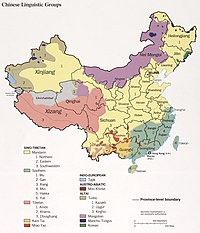Languages
Main articles: Languages of China and List of endangered languages in China
1990 map of Chinese ethnolinguistic groups
Standard Mandarin, a variety of Mandarin based on the Beijing dialect, is the official national language of China and is used as a lingua franca in the country between people of different linguistic backgrounds.[412]
Chinese characters have been used as the written script for the Sinitic languages for thousands of years. They allow speakers of mutually unintelligible Chinese varieties to communicate with each other through writing. In 1956, the government introduced simplified characters, which have supplanted the older traditional characters in mainland China. Chinese characters are romanized using the Pinyin system. Tibetan uses an alphabet based on an Indic script. Uyghur is most commonly written in a Perseo-Arabic script. The Mongolian script used in China and the Manchu script are both derived from the Old Uyghur alphabet. Modern Zhuang uses the Latin alphabet.
Urbanization
See also: List of cities in China, List of cities in China by population, and Metropolitan regions of China
Map of the ten largest cities in China (2010)
China has over 160 cities with a population of over one million,[417] including the seven megacities (cities with a population of over 10 million) of Chongqing, Shanghai, Beijing, Guangzhou, Tianjin, Shenzhen, and Wuhan.[418][419][420] By 2025, it is estimated that the country will be home to 221 cities with over a million inhabitants.[413] The figures in the table below are from the 2010 census,[3] and are only estimates of the urban populations within administrative city limits; a different ranking exists when considering the total municipal populations (which includes suburban and rural populations). The large "floating populations" of migrant workers make conducting censuses in urban areas difficult;[421] the figures below include only long-term residents.
|
Largest cities or towns in China
Sixth National Population Census of the People's Republic of China (2010) |
|||||||||
|---|---|---|---|---|---|---|---|---|---|
| Rank | Name | Province | Pop. | Rank | Name | Province | Pop. | ||
 Shanghai  Beijing |
1 | Shanghai | Shanghai | 20,217,700 | 11 | Chengdu | Sichuan | 6,316,900 |  Chongqing  Guangzhou |
| 2 | Beijing | Beijing | 16,446,900 | 12 | Nanjing | Jiangsu | 6,238,200 | ||
| 3 | Chongqing | Chongqing | 11,871,200 | 13 | Shenyang | Liaoning | 5,718,200 | ||
| 4 | Guangzhou | Guangdong | 10,641,400 | 14 | Hangzhou | Zhejiang | 5,578,300 | ||
| 5 | Shenzhen | Guangdong | 10,358,400 | 15 | Xi'an | Shaanxi | 5,399,300 | ||
| 6 | Tianjin | Tianjin | 9,562,300 | 16 | Harbin | Heilongjiang | 5,178,000 | ||
| 7 | Wuhan | Hubei | 7,541,500 | 17 | Suzhou | Jiangsu | 4,083,900 | ||
| 8 | Dongguan | Guangdong | 7,271,300 | 18 | Qingdao | Shandong | 3,990,900 | ||
| 9 | Hong Kong | Hong Kong | 7,055,071 | 19 | Dalian | Liaoning | 3,902,500 | ||
| 10 | Foshan | Guangdong | 6,771,900 | 20 | Zhengzhou | Henan | 3,677,000 | ||
Education
Main articles: Education in the People's Republic of China and List of universities in China
In February 2006, the government pledged to provide completely free nine-year education, including textbooks and fees.[427] Annual education investment went from less than US$50 billion in 2003 to more than US$250 billion in 2011.[428] However, there remains an inequality in education spending. In 2010, the annual education expenditure per secondary school student in Beijing totalled ¥20,023, while in Guizhou, one of the poorest provinces in China, only totalled ¥3,204.[429] Free compulsory education in China consists of primary school and junior secondary school between the ages of 6 and 15. In 2011, around 81.4% of Chinese have received secondary education.[430] By 2007, there were 396,567 primary schools, 94,116 secondary schools, and 2,236 higher education institutions in China.[431]
As of 2010, 94% of the population over age 15 are literate,[432] compared to only 20% in 1950.[433] In 2009, Chinese students from Shanghai achieved the world's best results in mathematics, science and literacy, as tested by the Programme for International Student Assessment (PISA), a worldwide evaluation of 15-year-old school pupils' scholastic performance.[434] Despite the high results, Chinese education has also faced both native and international criticism for its emphasis on rote memorization and its gap in quality from rural to urban areas.



No comments:
Post a Comment